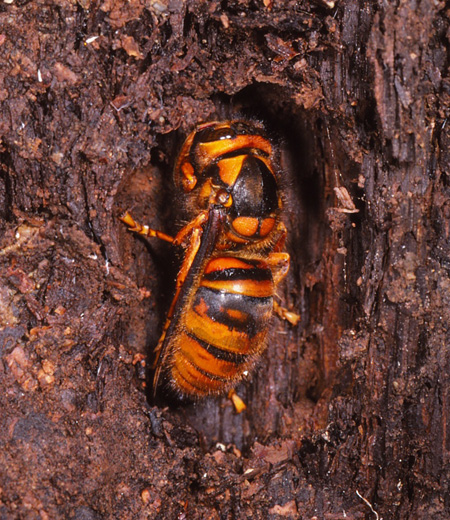Takao 599 museum has all kinds of animals inhabit in Mt. Takao in various ways of exhibitions such as seasonal wild plants preserved in acrylic and all kinds of animals specimens inhibits in Mt. Takao. On the "NATURE WALL," stuffed animals are displayed and shows the movie to introduce the dynamic nature of Mt. Takao.

They live widely in main land Honsyu, Shikoku, Kyusyu as well as Sado Island, Tsushia Island and Yakushima Island.
They live near populated area with trees growing thickly or copses in low lands to undeveloped woodlands.
They are medium size hornet smaller by one size than Japanese giant hornet.
Worker bees are about 20 mm, male about 20 to 24 mm , Queen Bee about 25 to 28 mm.
Early spring is the season they begin to appear and start to make their spherical shape beehive in the hollow on the trees or underground.
Recent years, the problem is they make their beehives such as overhangs of a Japanese roof of residential house, walls of residence in urban areas.
As its name shows their body color is conspicuous yellow.
As their characteristic is so offensive that even small stimulus urges them to attack humans.
Therefore, it’s recommended not to come near even when you happen to see beehives.
They love nectar or sap, and catch to eat various insects such as cicada at times.
●Length about 20 to 28 mm
●Adult Flight Season April to about November
They live near populated area with trees growing thickly or copses in low lands to undeveloped woodlands.
They are medium size hornet smaller by one size than Japanese giant hornet.
Worker bees are about 20 mm, male about 20 to 24 mm , Queen Bee about 25 to 28 mm.
Early spring is the season they begin to appear and start to make their spherical shape beehive in the hollow on the trees or underground.
Recent years, the problem is they make their beehives such as overhangs of a Japanese roof of residential house, walls of residence in urban areas.
As its name shows their body color is conspicuous yellow.
As their characteristic is so offensive that even small stimulus urges them to attack humans.
Therefore, it’s recommended not to come near even when you happen to see beehives.
They love nectar or sap, and catch to eat various insects such as cicada at times.
●Length about 20 to 28 mm
●Adult Flight Season April to about November
